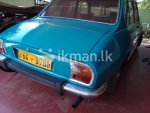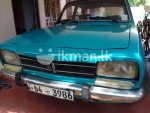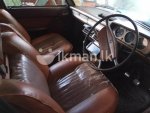Dear friends,
Yesterday my friend bought a 1970 504.



It was registered to the first owner since new. Later given to her daughter.
It had original seats and original door cards. Body was totally repaired and painted because of rust.
Those seats were so comfortable!! And the car was really spacious. Steering was wobbly and brake pedal juddered when pushed. Something was not right with the steering.
It did have IRS!! but drum brakes in the rear. No vents in the C-pillar. All the chrome bits were intact.
It did have a Toyota diesel engine in it but the upside is the Toyota 5 speed gearbox. Had aftermarket A/C and it worked pretty well.
Both right side doors were sagging a bit. And two window winders were just spinning without raising the glass.
Driver side window frame was cracked at the base (where the door lock is present). Gotta weld carefully without ruining the chrome trim.
Few questions here.
1. Did the speedo run with a cable?
2. Any suggestions on how to get the tacho running?
3. Would be better if the temp sender of the Toyota engine matches the original gauge. Would anyone have the resistant figures of the original sender?
4. fuel gauge won't bottom when tank is empty. any fixes to this?
5. Rear diff was a bit oily. Is there any kind of seal that would stop the leak? (had the rear driveshaft boots undamaged)
6. the clutch went to floor when pressed lightly but when you push it suddenly (pump action), it works well and held the pressure (I initially thought the clutch pump seals were leaking). Is this normal?
Yesterday my friend bought a 1970 504.



It was registered to the first owner since new. Later given to her daughter.
It had original seats and original door cards. Body was totally repaired and painted because of rust.
Those seats were so comfortable!! And the car was really spacious. Steering was wobbly and brake pedal juddered when pushed. Something was not right with the steering.
It did have IRS!! but drum brakes in the rear. No vents in the C-pillar. All the chrome bits were intact.
It did have a Toyota diesel engine in it but the upside is the Toyota 5 speed gearbox. Had aftermarket A/C and it worked pretty well.
Both right side doors were sagging a bit. And two window winders were just spinning without raising the glass.
Driver side window frame was cracked at the base (where the door lock is present). Gotta weld carefully without ruining the chrome trim.
Few questions here.
1. Did the speedo run with a cable?
2. Any suggestions on how to get the tacho running?
3. Would be better if the temp sender of the Toyota engine matches the original gauge. Would anyone have the resistant figures of the original sender?
4. fuel gauge won't bottom when tank is empty. any fixes to this?
5. Rear diff was a bit oily. Is there any kind of seal that would stop the leak? (had the rear driveshaft boots undamaged)
6. the clutch went to floor when pressed lightly but when you push it suddenly (pump action), it works well and held the pressure (I initially thought the clutch pump seals were leaking). Is this normal?

